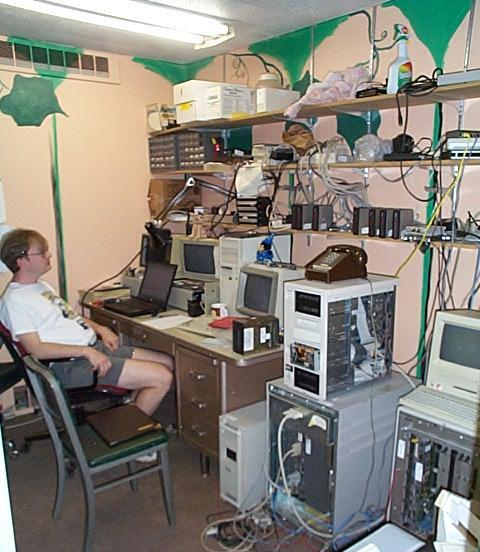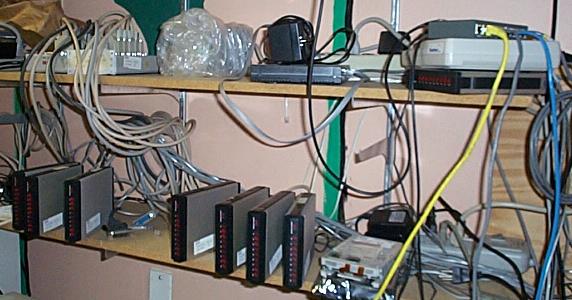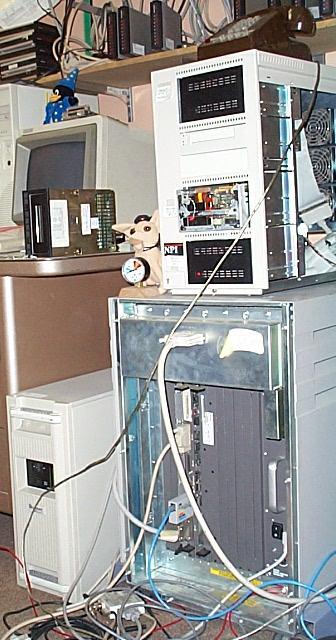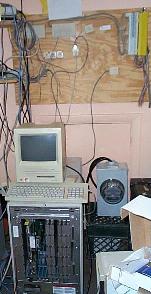 Grex's computers are housed in small windowless room in an
old industrial building in Ann Arbor, Michigan.
We rent this space for a bit more than $60 a month
(not including electricity).
We refer to this room as "The Pumpkin."
This web page gives a short tour of it.
Grex's computers are housed in small windowless room in an
old industrial building in Ann Arbor, Michigan.
We rent this space for a bit more than $60 a month
(not including electricity).
We refer to this room as "The Pumpkin."
This web page gives a short tour of it.
We have been housed in this location since late in 1996. You can see what the room looked like shortly after we moved in the old version of this tour. Before moving to the pumpkin, we were housed in "The Dungeon", an even smaller room in the basement of a 150-year old house. You can see that in an even older version of this tour.
To help you visualize how all the pictures shown here fit together,
the map at left gives a schematic view of how the pumpkin is arranged.
The red stuff is the working Grex computer system.
The blue stuff is various spares and stuff.
The black stuff is walls and furniture.
The room is not as neat as the map.
 Our first image shows Mark Conger seated at Grex's console.
Mark isn't actually working on the system. He's Grex's treasurer and he's
attempting to take
inventory
of all the stuff we've accumulated in the
pumpkin in the last five years. The sleak modern laptop on the desk in
front of him is his own system, not part of Grex.
Our first image shows Mark Conger seated at Grex's console.
Mark isn't actually working on the system. He's Grex's treasurer and he's
attempting to take
inventory
of all the stuff we've accumulated in the
pumpkin in the last five years. The sleak modern laptop on the desk in
front of him is his own system, not part of Grex.
Mark's presence here is actually rather unusual. Not only does the treasurer not spend much time in the Pumpkin, but neither does anyone else. We often go a month or more without anyone going there at all. So to visualize the room accurately, think of it with the lights off and no human being in sight.
Behind the laptop you see three monitors and a small tower-style computer case. The monitor in the center is for Grex's actual console. It is an original 8086 IBM PC with a monochrome monitor, a 20 megabyte "hardcard" for a disk drive, and a note stuck to the monitor advising people to be patient when rebooting it because it is really, really slow. It's probably not the last one in service anywhere in the world, but there can't be many. The only thing we run on it is the Kermit terminal emulator. So for our purposes, it is just a terminal with scrollback.
The monitor to the left of that is a spare IBM PC. It is there just in case the main one finally croaks. They're hard to get these days, you know.
The computer on the right, with the mini-tower case, is a 100MHz Pentium with 48M of RAM and something like 2 Gigs of disk running OpenBSD Unix (don't tell the poor penguin sitting on top of it - he probably thinks it's Linux). This machine is called "gryps". It used to be our router, but now it is just a tftp server for the terminal server (providing it with a more modern version of their its when it boots up, and a gateway system that the staff uses to ssh through into Grex when Grex's telnet queue is full.
It should be obvious why the room is called "The Pumpkin".
The walls are orange and there are pumpkin leaves and flowers,
plus the occasional butterfly painted on it. Interesting, eh?
The wall color was supplied by a previous tenant (possibly "Word of God").
Inspired Grex volunteers added the pumpkin leaves to complete the theme.
Unfortunately, shelves and phone boards cover most of the decoration.

A huge tangle of cables snakes upward from the modems to terminal server,
a Chase IOLan, which is in the upper left-hand corner of the picture.
It is befestened with stickers containing instructions for how to reboot it.
This is connected to our ethernet hub, on top of the stack of boxes in the
upper right-hand corner of the picture. Under the hub is the DSL modem,
which is Grex's interface to the internet. Under the DSL modem is an
28.8 baud Hayes modem, which holds the DSL modem up.
 Here's the actual Grex computer. It stands on the floor to the right of
the desk, with a white UPS wedged in between it and the desk, and a four-bay
SCSI chassis standing on top of it.
The big box you see is a 12-slot VME chassis. We bought it from University
of Michigan Property Disposition. It came with a Sun 4/370 inside it, but
we just pulled the cards out and stuffed them into our heap of stuff we might
use someday. What we wanted was the chassis, which is built solid as a 1932
Ford, with slots for 12 VME boards, a quality power supply on the right side
(the thing with the silver handle), drawers for four SCSI disks in the top
section, and an array of 9 fans in the bottom (if it wasn't so heavy, it'd
make a fine hovercraft). It's actually standing with it's face to the wall,
because the interesting stuff is all in back.
Here's the actual Grex computer. It stands on the floor to the right of
the desk, with a white UPS wedged in between it and the desk, and a four-bay
SCSI chassis standing on top of it.
The big box you see is a 12-slot VME chassis. We bought it from University
of Michigan Property Disposition. It came with a Sun 4/370 inside it, but
we just pulled the cards out and stuffed them into our heap of stuff we might
use someday. What we wanted was the chassis, which is built solid as a 1932
Ford, with slots for 12 VME boards, a quality power supply on the right side
(the thing with the silver handle), drawers for four SCSI disks in the top
section, and an array of 9 fans in the bottom (if it wasn't so heavy, it'd
make a fine hovercraft). It's actually standing with it's face to the wall,
because the interesting stuff is all in back.
VME boards are about the size of a placemat. Though our case could hold twelve of them, we are only using two, though being double-slot cards, each occupies two slots. Slot two (and three) contains a 4/6xx motherboard. This has a built-in SCSI controller, an ethernet interface and a serial port for the console. Plugged into it are two SM100 modules, each containing two 40MHz Ross CPUs, so the system has a total of four 40 MHz Sparc processors. Also plugged into the motherboard are 32 4-Meg SIMMs, giving 128 megabytes of memory on the main board. It has slots for several SBus modules, but we aren't using any yet (we are going to have to add a second SCSI chain soon, which will require adding an SBus SCSI controller module).
The second card, in slot four, is a memory expansion card, containing 64 more 4-Meg SIMMs, bringing the total system memory up to 384 megabytes. These cards are hard to get, and the one we found had been badly abused and needed lots of TLC to get it to work.
This particular set of components in this particular type of chassis makes this a rather well-equipped Sun SparcServer 4/670. It was the last VME system Sun built and back in 1991 these were sold as enterprise servers for a whale of a lot of money (likely around $50,000 for the system without the memory. The memory would probably have cost around $150,000 in those days). These days, the average single-processor Pentium you see in computer stores could out-perform it by an order of magnitude or so, and systems like this are being pushed into dumpsters worldwide. However this system's heredity as a top-of-the-line enterprise server shows in the all-around solidity and robustness of its design. In a world full of fast, but cheaply designed and built computers, this is, if you look at it from the right angle, a thing of beauty.
The blue cable plugged into the back of the motherboard connects Grex to the ethernet hub. The white cable just above it loops around to the four-bay SCSI enclosure on top of the VME chassis. Another SCSI cable loops back down and plugs into the top part of the VME chassis, where there are more drive bays. Currently there are two hard disk drives hidden inside the top of the VME chassis, and three more in the NPI SCSI enclosure (one with colorful guts hanging out). Each of these three drives is 2.1 gigs, for 10.5 gigs of total disk space. We have heaps more second-hand 2.1 gig disks, and will probably put more of them on line next time we find time.
Also in the external SCSI enclosure is a 8mm Exabyte "Mammoth" tape drive. This can store 20GB on a tape and is used to make backups of the system whenever we think of it, which isn't very often. There is an old dead tape drive laying on the desk above the UPS.
Grex also sports a pressure gauge (permanently reading in the red zone) and
a stuffed chihuahua wearing a beret.
 Next to Grex is another 12-slot VME chassis. We started out setting this
up as a development system, but haven't yet got around to installing a disk
and an operating system on it, so it is non-functional. It contains another
4/6xx motherboard, with more Ross CPU modules, but substantially less memory.
This is all spare equipment, that can be swapped into Grex quickly if the
main system dies. Sitting on top if it is it's console, a Macintosh SE
borrowed from staff member Jan Wolter.
Next to Grex is another 12-slot VME chassis. We started out setting this
up as a development system, but haven't yet got around to installing a disk
and an operating system on it, so it is non-functional. It contains another
4/6xx motherboard, with more Ross CPU modules, but substantially less memory.
This is all spare equipment, that can be swapped into Grex quickly if the
main system dies. Sitting on top if it is it's console, a Macintosh SE
borrowed from staff member Jan Wolter.
Above it is the phone board. This is a chunk of plywood that we nailed to the wall above a little trap door that leads to a crawlspace under a stairwell adjoining our office. Coming in a hole in the lower right-hand corner is the end of the 50 conductor cable that we strung down into the building's basement phone closet. It ties in to the yellow punch-down block on the right side, which connects to an assortment of phone jacks, which the modems connect to. We put the 50-conductor cable before we knew that dial-in lines were going to go the way of the dodo bird.
You'll also notice an electric watt-hour meter tucked in the corner, just
like the ones you see on houses. Our rent doesn't include electricity,
but our room doesn't actually have a separate meter, so our lease requires
us to come up with a fair estimate of our power usage. So all our equipment
is plugged into our meter.
 Along the other side of the room are two sturdy steel shelves loaded and
engulfed by a great huge heap of stuff.
Plainly visible in this picture are:
Along the other side of the room are two sturdy steel shelves loaded and
engulfed by a great huge heap of stuff.
Plainly visible in this picture are:
More information about Grex's hardware and software is available in another
staff note page,
About Grex's Hardware
and Software.